Locations of Houses & Businesses
Sign my Guestbook
 View my Guestbook
View my Guestbook
| View this page at 1024x768
Contact Webmaster
This page last updated Feb 2009.
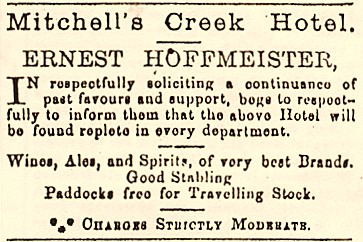
Advertisment from 'The Wellington Times' January 1873.
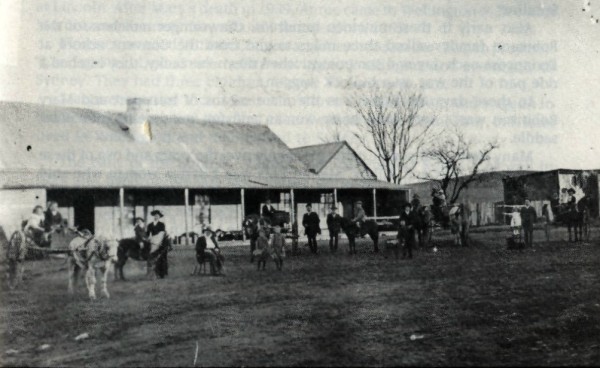
Lincoln Inn (image - Keith Edwards)

Lincoln Inn mail car (image - Keith Edwards)
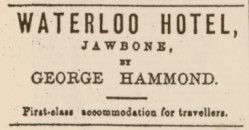
Advertisement from 'The Wellington Times' January 1873.
Can you help with any information or pics on old hotels ANYWHERE in the Wellington district?
Contact Barbara Preston
|
The Township of Bodangora
The township of Bodangora, as we know it today, was proclaimed in 1897, approximately 30 years after gold mining had commenced in the district. Bodangora had been formerly known as the 'Mitchell's Creek Freehold Gold Mining Estate' and 'Daviesville'. However, several settlements in the district had preceded Bodangora.
Lincoln
The settlement at Lincoln probably formed first in the 1860's at the Mitchell's Creek crossing on the main Wellington - Mudgee road. A combined Inn, store & Post Office were established here to service the travellers on this road, as well as those taking up selections in the area. Official Post Office records date back to 1874. This Inn was owned by Ernest Hoffmeister for many years, before he sold it to the Robinson family in 1891. The name had been changed to the Redbank Hotel, and the Robinsons subsequently changed the name to the Lincoln Inn. When the resurgence of mining occurred at the Mitchell's Creek Freehold Estate in 1889, Hoffmeister had the contract to deliver their mail the 3 miles or so to the minesite.
After taking over the responsibility of running the business after the death of her father in 1904, Mary Robinson continued to do so until she married James Harvey in 1922. The hotel licence had been cancelled in 1914, so she sold the land and shifted the Post Office to her husband's house on a nearby hill. She continued to operate the Post Office until her death in 1959.
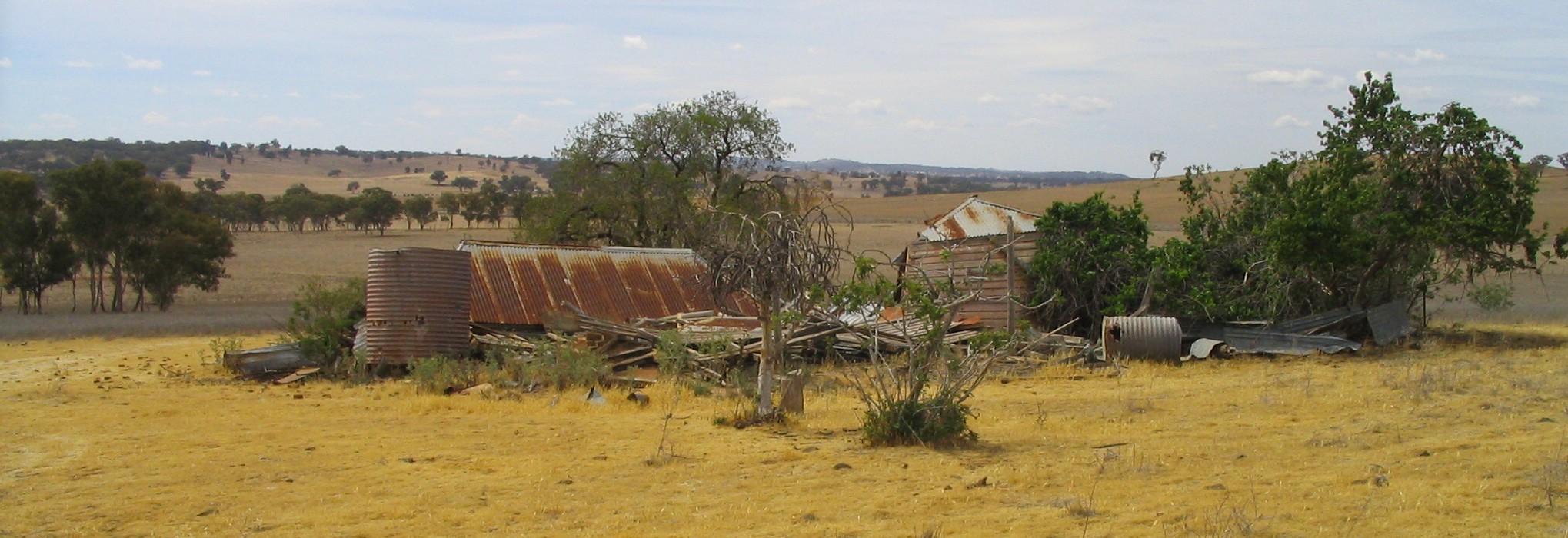
The remains of Mary Harvey's Lincoln Post Office in 2006. The hill overlooks the site of the original Lincoln settlement.
Jawbone
Jawbone, several miles closer to Wellington from Lincoln, also on the main road, developed after the discovery of alluvial gold early in the 1870's. As indicated by the advertisement for the Waterloo Hotel, this settlement catered for travellers, as well as local settlers.
Kaiser
Kaiser township formed around a crushing plant on the banks of the Mitchell's Creek, near the crossing on the road from Jawbone to Comobella. This crossing became known as 'Kaiser Crossing'. This settlement also had its own public house as indicated in this article in the Wellington Times, April 24, 1899.
'The old Kaiser Public House is being pulled down, it is being removed to Mrs. Gollan's selection, the pine timber in it as good as the day it was erected'.
This was at the time when the residents of Kaiser had been shifting to the new township of Bodangora, at the top of the hill overlooking the Wellington Valley and adjacent to the booming Mitchell's Creek gold mine.
|
The Mitchell's Creek Freehold Gold Mining Estate & Daviesville
With the resurgence of the Mitchell's Creek quartz reef gold mine in 1889 came the beginning of the township that came to be known as Bodangora.
In 1890 the 40 or so residents of Mitchell's Creek pushed to have the coach that was contracted to take mail from Wellington to Mudgee twice weekly, diverted to travel through their settlement. This attempt failed and as a compromise, the Postmaster at Lincoln (Mr. Hoffmeister) was contracted to deliver mail to Mitchell's Creek by 'branch horse mail' twice weekly, for the sum of £10 per annum. This was the first recognition by the NSW Post & Telegraph Office, that a township existed. Mr. Hoffmeister found difficulty delivering the mail as the men were at work in the mine, so a Receiving Office was established at the store run by Robert Smith. Both Mr. Smith 'an intelligent and respectable man', and his '-- new weatherboard building in which he has a General Store' were deemed satisfactory for the position by the authorities.
Subsequent proprietors of the General Store at Mitchell's Ck, Lincoln, were H. Carter, M. McCormack and W. Rowan, who was Receiving Officer in Nov 1892 when the township became officially known as Daviesville. This came about after protests from people in the Comobella district about apparent confusion and mail delivery problems attributed to the name Mitchell's Creek. The name Daviesville came from Mr. Davies who was mine manager at the time. Shortly after, in March 1893, a daily mail service was started, to service the now 200 or so residents, and this extra traffic brought about the upgrading of the Receiving Office to a Post Office, and William Rowan became the first Postmaster.
William Rowan was still postmaster when the name Daviesville was changed officially to Bodangora in January 1897.
|
|
Bodangora
Wellington Times
August 11th 1898
'Bodangora no longer sleeps. There is a general all round boom on. First there is the building craze. Most everybody has it, the erstwhile houseless one, seems to be bursting with ambition to possess something to call 'my place' and he who has that possession seems to be unable to rest till 'that there kitchen' has been re-roofed, or a few slabs are put into the north end of the dining room, so on, also so forth. If 'variety is charming' then we have lashings of that quality in the building material used - from weatherboards and iron right away down to soogee bags and sardine tins'.
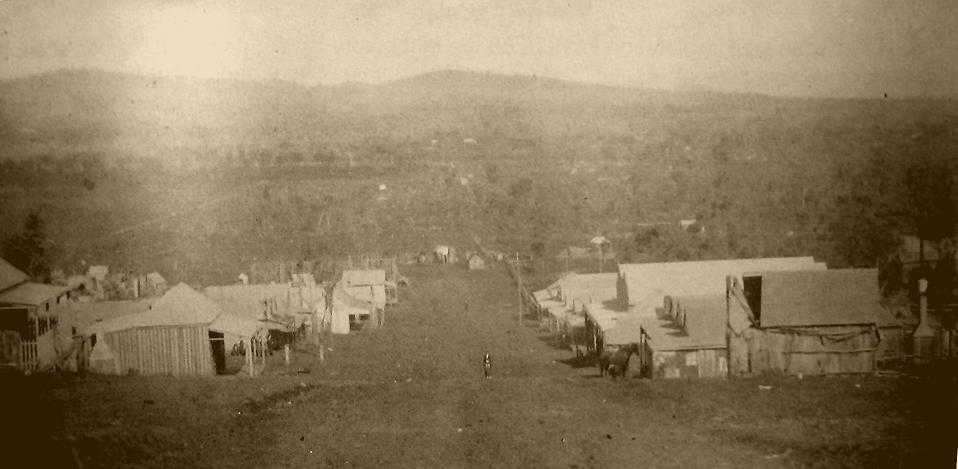
Looking down Bodangora Hill abt 1900. Robinson's Store shown in pic later on this page, is second building on right.
Post Office
In July 1897 a petition was circulated to '-- authorise and establish a Government Post and Telegraph Office at Bodangora and in charge of a Government Official'
The petition was signed by: 1 - Engineer - 82 Miners - 9 Engine Drivers - 1 Assayer - 1 Amalgamator - 2 Vannersmen - 3 Truckers - 12 Labourers - 1 Farrier - 3 Blacksmiths - 1 Fitter - 1 General Contractor - 1 Carpenter - 6 Storekeepers - 2 Boarding House Keepers - 5 Butchers - 1 Baker - 1 Bootmaker - 1 Laundress - 2 Hairdressers - 1 Watchmaker - 1 Tobacconist - 2 Tailors - 6 Carriers - 1 Bandmaster - 13 Farmers & 2 Graziers.
This was not granted, and William Rowan sold his business to the Wise family who in turn sold it to P.C. Trotter in Dec 1903. Mr. Trotter ran the Post Office from his store until an official building was opened in March 1905, next door, with William Smith the Postmaster.
|
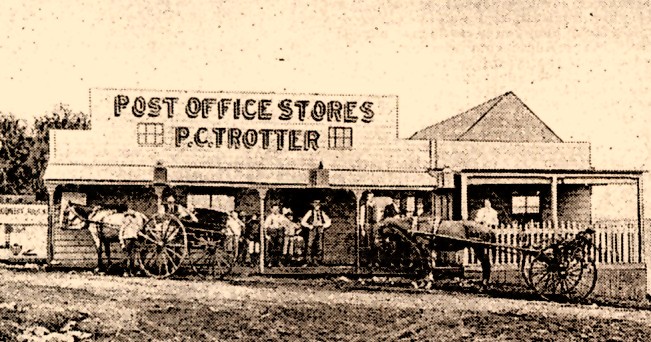
The original PO in 1904. This same building had been used as PO since 1890 and was replaced by the new PO shown at right, in 1905 (& continued operating until 1960? when duties were transferred to the school residence). This building still stands today (2007).
|
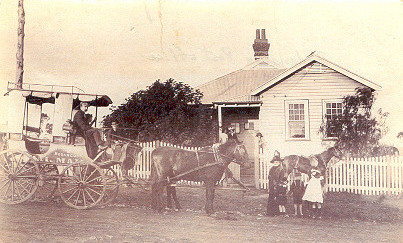
|
|
Wellington Times
September 14th 1899
'Anyone visiting Bodangora after an interval of 3 years cannot but remark the advancement of the mining township. A more settled appearance, the gradual displacement of bark humpies for more sightly buildings tend to prove that the residents are satisfied with the permanency of the mine. The longevity of mining townships generally cannot be relied upon, and perhaps this accounts for houses being more primitive than in settled districts. However Bodangora does not lag behind its fellows in this respect, many neat buildings are seen, and, if not odious to make comparisons, Dr. Rygate's domicile is the peer in this respect. Its situation on high ground commanding a good view all round and its neat finish confers special lustre to it.
The only government buildings are the Police Station and the Public School. We visited the latter and were struck with the neat appearance of the children and the earnest and happy interest exhibited in their work. The school is under the able management of Mr. P.L. Kable, a gentleman highly respected by the residents. His assistants are Miss McCormick and Miss Gable. The attendance averages 170 children. Additional room is required, and we understand will shortly be provided. Mr Henry Wise attends to the Post & Telephone Office, and is a most obliging and courteous officer.
The library comprises about 700 volumes besides the daily and weekly metropolitan journals and the 'Gazette'. Mr. Dick presented the institution with books to the value of £100 and considering the membership fee is only 2s 6p per half year, all should avail themselves of its benefits.
We understand the main shaft of the mine is 700 feet deep and looking well, the fortnight yield of gold about 370 ounces and that 200 men are employed by the mine proprietary. The road from Wellington to within a short distance of Bodangora is good, but thence we luckily miss a stump, only to take refuge in a rut, and after several sundry bumps of more or less consequence, reach the outskirts of the town, and then have to use moral suasion in urging our medicative steed up the steep and rugged incline. Taking into account the size and importance of the place and the increasing traffic, the road should be improved'.
|
|
Boom Years - 1900 - 1908
During the first years of the 1900's, Bodangora enjoyed its boom years. Despite much opposition, the Tattersall's hotel was built opposite No. 1 shaft, and the expanding output of the mine, supported an increasing population which required more services. Also during this period there was much activity at Jawbone, and a thriving settlement also existed there. Business houses in Bodangora in 1908, when the mine first gave indications it was facing problems, included Bakers, Butchers, Fruiterers, General Stores, Boots and Shoes, Tailors, Drapers, Tinsmiths, Blacksmiths & Billiard Saloons as well as the Hotel. Mine employment peaked in 1905 when an average of 228 men were employed.
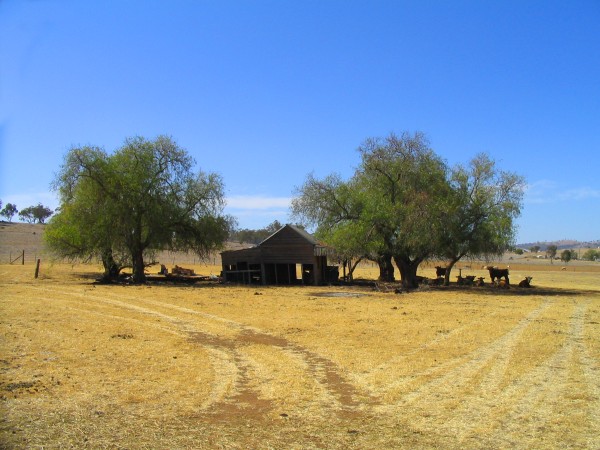 -- --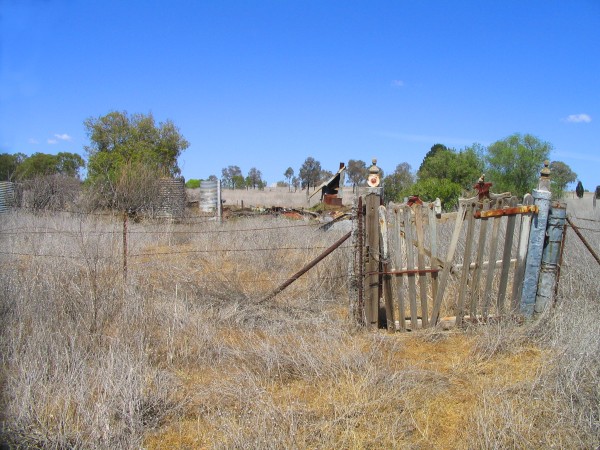 -- --
Little remains of the township. Many buildings were transported to other areas, and those that remained are almost all gone. At left the home of Bill & Ivy Inwood - middle was home of Jack Reid & at right Kelly's farm?? near Dick's Reward mine.
|
|
Wellington Gazette
March 7th 1907
A Terrific Cyclone - Trees Uprooted - Churches Blown Down - Houses Levelled
'Last Monday night a remarkable cyclone visited the district. It seems to have been at its worst in the vicinity of Bodangora. --- A resident thus describes:- For a little while before the storm which broke over the town about 7-30pm, there was a great silence, and that feeling as if something was going to happen came over one. Then a sound from the north-west, as of a railway train at full speed, was heard, and for several minutes the place was a veritable pandemonium, and the noise of flying iron and timber was heard distinctly above the howling of the storm'.
How it struck the town
'Houses were taken in the fierce grip of the wind and thrown bodily from their foundations. Women were fleeing in terror to places of shelter, and as they fled were in danger of being stricken down by flying missiles and trees which had been uprooted bodily. Strong men were afraid, and in many cases the residents extinguished the lights, so that if the house were moved, there might not be the added horror of fire. --- There are numerous accounts of miraculous escapes, but fortunately there is no loss of life to report and no case of severe hurt. --- '
An added discomfort
'To make matters worse, directly the damage had been done by the wind, the rain came down in torrents, and the discomfort of the people can be imagined. Nearly every house was flooded, and beds saturated. In the darkness no one was able to estimate the damage. Many people walked the streets until daylight appeared --'.
|
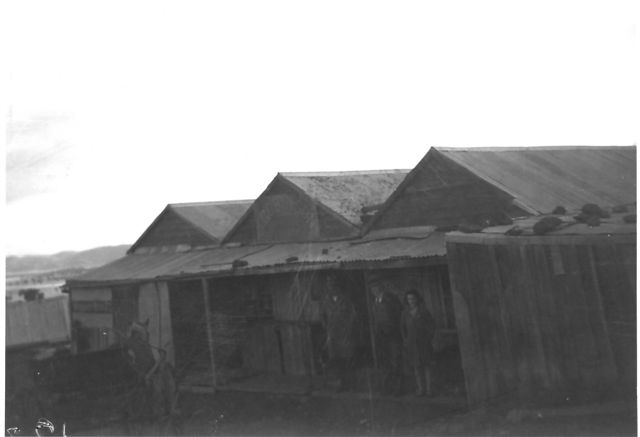 -- --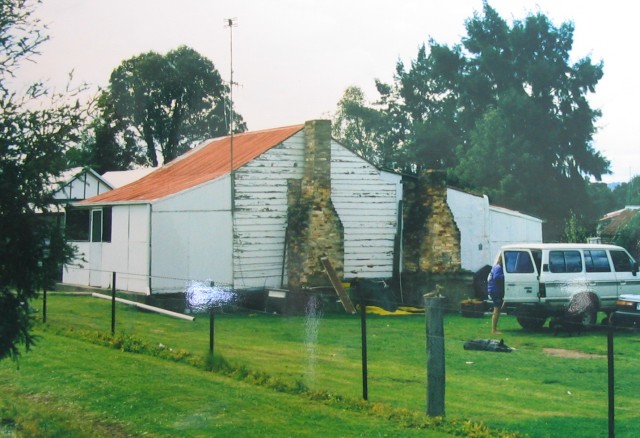 -- --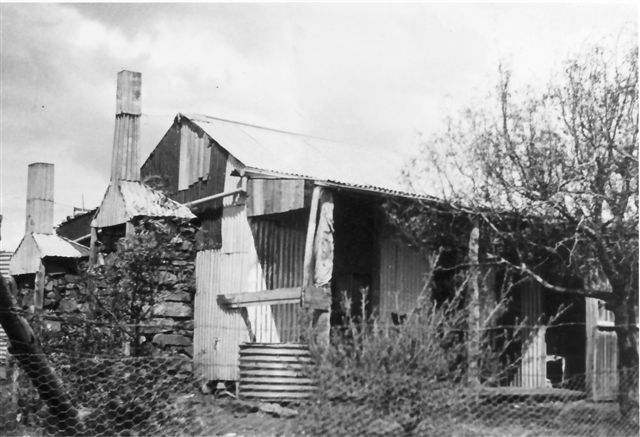
At left - Robinsons Store, halfway up the hill on the mine side. Centre - Bodangora miner's hut transported to Mumbil. (Information & image provided by Kerry Pascoe - nee Forrest). At right Bill Bowers house at Bodangora.
|
|
Wellington Gazette
May 7th 1908
Closed Down - Bodangora Mines Cease Work
'The news which we published in our issue of Monday last to the effect that the mines at Bodangora were likely to close down, has unfortunately proved to be true. Between 60 and 70 men were knocked off on Monday, and during the week others have received their marching orders, about 200 in all being thrown out of employment. Worse still, the closing down is not a temporary one. The mines have not been paying for some time, and, as a matter of fact, in the light of information now available, it seems an extraordinary thing that operations have so long been perservered with'.
Poor gold & poor results
'Mr. David Manwell, manager of the property, which is known as the Mitchell's Creek Freehold Gold Estate, was seen by a representative of this paper on Tuesday morning. We asked Mr. Manwell for an authorative reason for the closing down. His reply was brief, but all-embracing. 'You can say', he said , 'that the mines have been closed down because they were not paying'. ------ The fact of the matter seems to be that the best of the mine has been taken out, and at the present depth the stone is of poor class. Added to this, the gold won is not of a rich quality, being worth only £3 3s per ounce. Work has almost entirely been confined of late to the Dick's Reward mine, and it now seems clear that operations in No. 1, etc, ceased because of their unprofitableness. With the petering out of the Dick's Reward, the end of the M.C. Mine appears to have come for the present'.
Cyaniding to continue
'Operations at the mine are not to cease, however. About 40 men will still find employment at the cyaniding works, which will be called on to treat something like 150,000 tons of tailings. This will mean work for about four years, so that Bodangora township is not yet to be wiped off the face of the map'. ----------
The effect at Bodangora
'The disastrous news of the closing of the mines has naturally had a most disturbing effect on the people of Bodangora, taking in a radius of two or three miles and including Jawbone, as 1900. The population of the township itself is about 1000, made up of men engaged at the mines, numbering 230, their wives and children and a number of business people and their families. The public buildings include public school, convent school, three churches (Anglican, Catholic and Baptist), Tattersal's Hotel (licensed by Mr. Fred Smith), three stores (Bodangora Branch Co-operative Stores, Ltd., Mr. James Robinson's and another), post and telegraphic office, butcher's, baker's, bootmaker's, and other shops, public hall, boarding houses, and a number of private dwellings. Most of the miners have neat little homes of their own, the buildings representing up to about £100 each in cost, with flower and kitchen gardens to add to their comfort and atractiveness. It is improbable that the majority of these homes will be forsaken, for it is likely that many of the men will endeavour to find work on the Commonwealth and Welcome Jack fields and other avenues in the vicinity, in which case Bodangora will continue to be their centre, at least for some time to come. It is highly probable however, that several of the business places will close down permanently sooner or later. An idea of what this will mean may be gleaned from the statement of one business man that he was doing a turn-over of £200 per week. In his case the closing down of the mines will not result in his removal, as he tells us that his district connection and the trade to be expected from what will remain in the township will justify him in keeping going there. The schools and post-office will undoubtedly continue on, though shorn of some of their importance, and there will always probably be an opening for a hotel. On the other hand there is sure to be an exodus of small business people'.
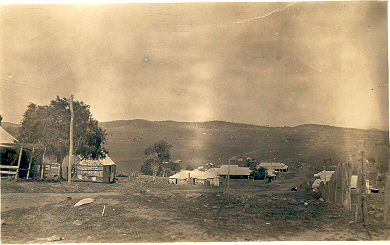
This 1909 image shows major changes in the view looking down Bodangora Hill, from the abt1900 one shown above. There are fewer houses, and the Post Office and Tattersall's Hotel are clearly visible as the last two buildings on the left side of the street - the Hotel being the furthest.
|
|
Down But Not Out - 1909 - 1919
The Mitchell's Creek Gold Recovery Co. & the Bodangora Gold Mining Co.
As mentioned in the above newspaper article, cyaniding of the tailings was to continue for an estimated four years, employing forty men. The newly formed Mitchell's Creek Gold Recovery Co. used a new cyaniding process which made it economically viable. This treatment of the sands and slimes continued in varying degrees by this company until they were superseded by Messr's Cameron and Sutherland around 1915-16, who continued operations until around 1919.
In 1910 the Mitchell's Creek Mine was purchased by a company that proposed to resume mining on an extensive scale. This mining was to concentrate on Dick's Reef, which was subsequently dewatered for the resumption of operations. In 1911 the Bodangora Gold Mining Co. commenced mining, and in 1912 employed an average of 120 men. This renewed underground mining activity was only temporary however, with employment dropping to 30 men by 1914, but increasing during the period of The Great War to an average of 64 in 1915, and 80 men in 1916.
When the Bodangora Gold Mining Co. ceased operating in early 1919, the population must have declined rapidly, so the end of Bodangora as a proper thriving township must have occurred around this time.
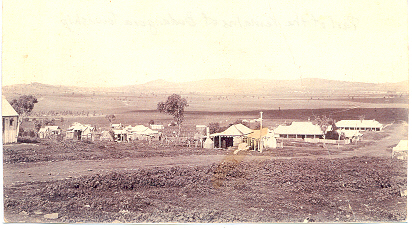 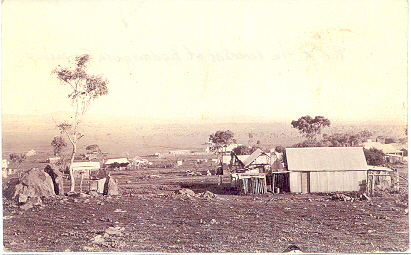
These 1909 images supplied by Keith Edwards. The pic at left shows the Post Office and the Tattersall's Hotel. These buildings also appear in the pic at right, taken from a position near the Church of England.
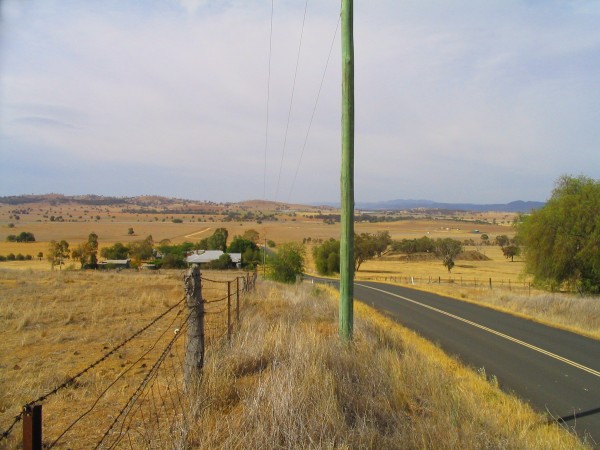 -- --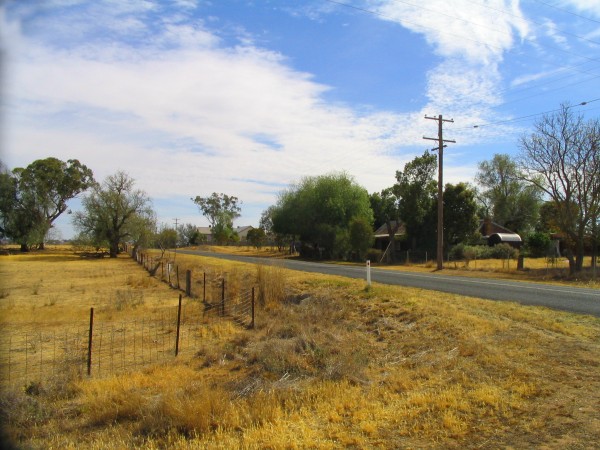 -- --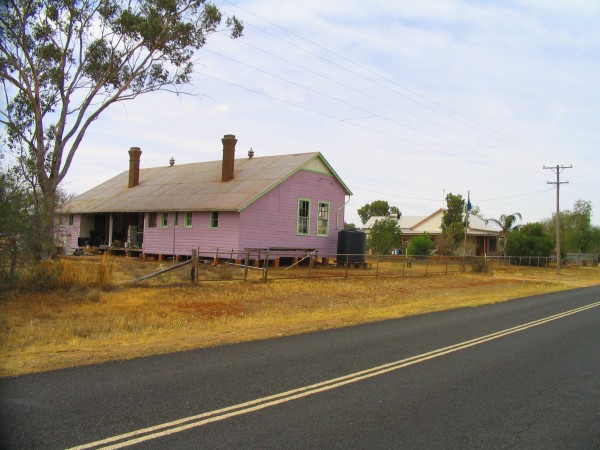
These 2006 images show some of Bodangora as it has been seen for many years. At left looking down the hill to the old Post Office - centre, the residence of the Carter family for many years with the School residence in the background - right, the School and residence.
|
 View my Guestbook
View my Guestbook




















